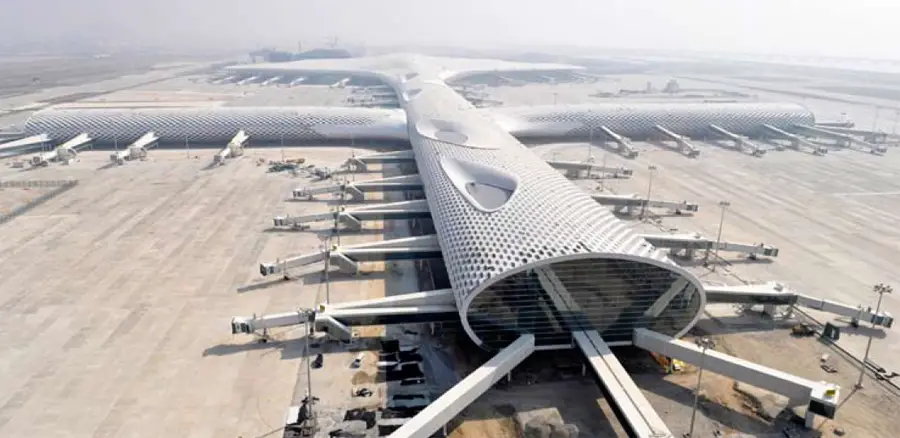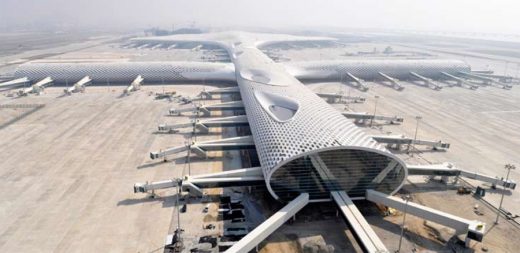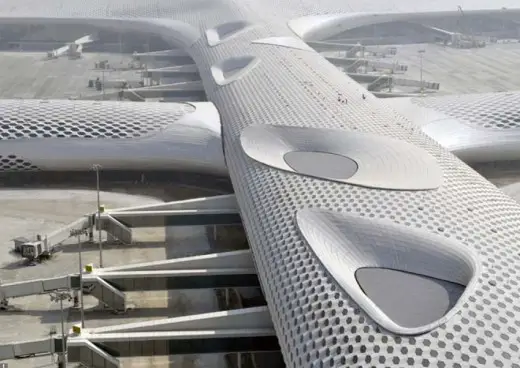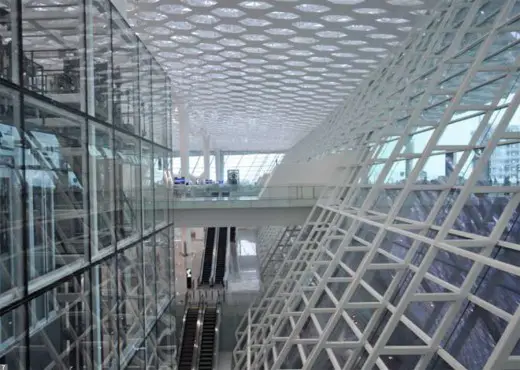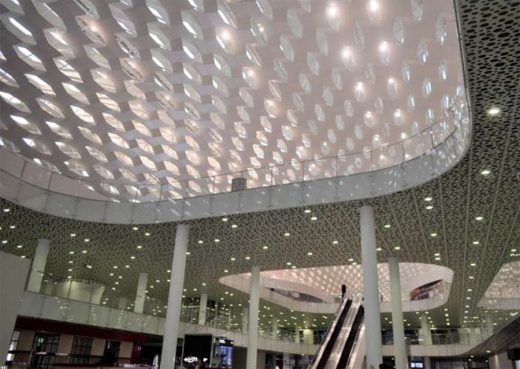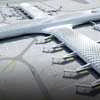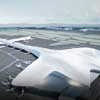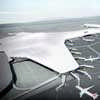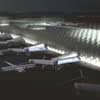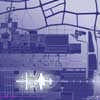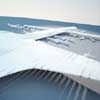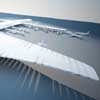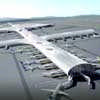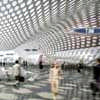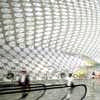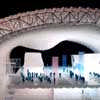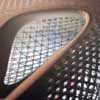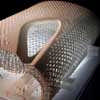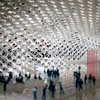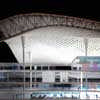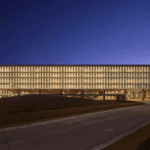Shenzhen Airport Building, Bao’an International, Terminal 3 Design Images, News, Architect, Project
Shenzhen Bao’an International Airport Building
New Terminal 3 Building, China design by Massimiliano Fuksas Architect, Italy
24 February 2022
Shenzhen Bao’an International Airport Satellite Concourse
Design Architect: Guangdong Province Architectural Design and Research Institute (GDAD), Aedas, Landrum & Brown (USA)
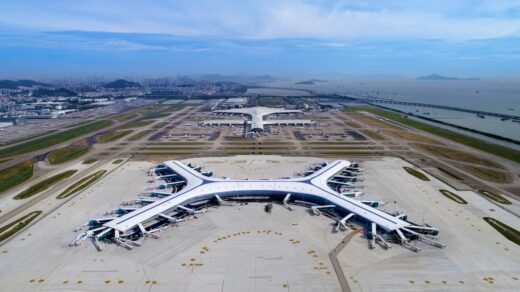
image source: China Construction Eighth Engineering Bureau Co Ltd; Photographer: Chen Yiran
Shenzhen Bao’an International Airport Satellite Concourse Design
The Shenzhen Bao’an International Airport Satellite Concourse jointly designed by GDAD, Aedas, and Landrum & Brown, is officially in operation from December 2021. Set directly to the north of the existing Terminal 3 building, it is a key step in the expansion project of one of the most important aviation hubs in South China.
27 + 26 Nov 2013
Shenzhen Bao’an International Airport Building, China
Grand Opening on November 28th
Design: Massimiliano Fuksas Architects ; engineers: Knippers Helbig
The new Terminal 3 at Shenzhen International Airport
Opening on 11.28.2013 – Just five years from tender to completion
On 28th November 2013 the new Terminal 3 at Shenzhen International Airport will open after just five years of planning and construction. With an overall length of 1,500 m and a gross floor space of 500,000 m2, it increases the capacity of the existing airport in future by up to 40 million passengers per year.
The project is the result of an international competition held in 2008, from which the team of Italian architect Massimiliano Fuksas supported by German engineers Knippers Helbig emerged victorious. Based on a given building organisation and floor plan structure, a freely shaped terminal design was developed allowing plenty of natural light through a large number of openings in the interior.
The terminal roof spans 700 m over the check-in area reaching a height of 25 m and is supported by slender columns in a 36 m grid layout. From there the route leads past restaurants to the main concourse, where the overview of the 1,000 m long section of the building – with its strongly modelled ceiling shape and groups of shops some extending over two floors – gives a spacious feeling. The concourses are column-free and in the transverse direction span up to 45 m. At the intersection with the cross-concourses branching off to the sides there is an approx. 80 m wide piazza.
The initial design development began with clay models by the architect M. Fuksas which were subsequently digitalised using Rhino 3d. Knippers Helbig then undertook the discretisation of the surfaces, implementing this with the aid of specially developed parametric software tools. The openings and inclination angles of the panes of glass were equally matched to each other as were the daylight and energy input.
Developing the geometry involved the specification of the structure the steel construction as well as the coordinates of all facade elements of the outer shell. The program allowed iterative optimisation of the facade at very short time intervals, making it possible to complete the preliminary design of both the facade and the structure within the short space of a year, with handover of the geometry, static and rule details of the framework and facade. The project planning was then taken over by the BIAD Office in Beijing.
Knippers Helbig was responsible for the development of structural solutions for the reinforced concrete of the arrival and departure levels as well as for the static analysis of the steel structures of the roof and facade. Here, the diamond-shaped structure refers directly to the honeycomb shape of the facade and is stiffened additionally by cross members. The spring-loaded bearing bolts of the steel structure permit uniform distribution of temperature and especially seismic loads on the supports, creating a unified impression of the structural elements up to 400 m long.
The building envelope is dominated by a honeycomb-like facade which through its double skin largely permits indirect light to enter the interior through 25,000 openings. Depending on the sun’s position, rays of sunlight also enter the building directly, offering unusual continuously changing lighting effects throughout the day. At numerous places along the concourses, strip-like windows offer panorama views of the airfield.
The success of project is the result of the close collaboration between Italian, German and Chinese planners and thanks to the great openness of the client towards innovative approaches to design and planning tools as well as unconventional technical solutions.
Shenzhen Bao’an International Airport – Building Information
Project: Shenzhen Bao’an International Airport – Bao’an district, Shenzhen, CN-Guangdong
Client: Shenzhen Airport Group Co. Ltd.
Architect: Massimiliano und Doriana Fuksas, Rom
Architect of record: BIAD (beijing institute of architectural design), Beijing
Structures / Facade / Parametric design: Knippers Helbig Advanced Engineering Stuttgart – NewYork
Structural design:
Thorsten Helbig, Florian Kamp, Fabian Friz, Dominik Honerboom, Li Amin
Facade design:
Florian Scheible, Roman Schieber, Milos Dimcic, Werner Roll
General Contractor: China State Construction Engineering Corporation, CN-Beijing
Developer: Shenzhen Airport Group Co. Ltd.
Lighting Consulting: Speirs & Major Associates, Edinburgh, London
Competition: 2007-08
Planning and construction period:2008-13
Completion:28. 11. 2013
Net surface:175,000 m2
Gross area: 500,000 m2
Volume: 2,500,000 m3
Facade surface: 300,000 m2
Shenzhen Bao’an International Airport images / information from Knippers Helbig
Knippers Helbig Advanced Engineering
21 Oct 2008
Shenzhen Bao’an International Airport Design
2008-
Design: Massimiliano Fuksas Architects
Images courtesy Studio Fuksas unless stated otherwise
Shenzhen is one of the most important industrial and touristical locations of whole China. Shenzhen is located in the southern portion of the Guangdong Province, on the eastern shore of the Pearl River Delta. Neighbouring the Pearl River Delta and Hong Kong, Shenzhen’s location gives it a geographical advantage for economic development.
Shenzhen International Airport Terminal will be the gateway to the city of Shenzhen..
The first and last image an air traveller has of a city are those created by the traveller’s impression of the airport. T3 in Shenzhen International Airport can positively influence the image that international, national business people and tourists have of Shenzhen.
The master plan for Shenzhen Bao’an International Airport intends to offer world-class transportation services. Achieving this means that Shenzhen airport must be operate at the following levels:
• Globally,
T3 at Shenzhen Bao’an International Airport must serve as the global aviation gateway between China and the rest of the world.
• Nationally,
As the fourth largest following Beijing, Shanghai, and Guangzhou in China, Shenzhen Bao’an International Airport is a trunk of domestic flights and hub of national flights. Enhancement of transfer services between international and domestici flights will improve the distribution of wealth among all Chinese cities.
• Regionally,
Currently, there are more than 40 cities with populations of over one million within 3.5 hours flying time of Shenzhen. This makes Shenzhen an excellent location for a regional hub. Passengers travelling from neighboring cities could fly to Shenzhen to connect with long distance global flights or flights to other Asian cities.
In construction terms, its design optimises the performance of materials selected on the basis of local availability, functionality, application of local skills, and low cost procurement. Remarkably, it will have been designed and built in just few years. For the complete of T3 Shenzhen Bao’an Airport there are three phases.
Phase 1 (in 2015)
Major facilities in Phase 1 will include the unit terminal with 63 contact gates, the first stage of the APM, traffic system, parking place, landscape, and shopping certre.
Train service for APM will not be available until the complete of Phase 2.
Phase 2 (in 2025)
Expansion after Phase 1 will occur based on masterplan. During Phase 2, the first remote passenger concourse will be constructed to add gates and the satellite terminal with rail stations will be operational. This will require expansion of the APM.
Phase 3 (in 2035)
Development of the airport’s west side will continue until about 2035 when T3 Shenzhen International Airport will be fully constructed.
Phase 3 continues the demand driven development process. The satellite terminal will again undergo expansion and more remote concourse will be added during this decade. And also there will be expansion of Terminal head house. The volume of extension of Terminal head house is going to be glass façade with glass roof so that the extension of building can have continuity in terms of construction material. Consequently this way of extension can have merits not only for the aesthetic reason but also for construction.
Designed for maximum flexibility to cope with the unpredictable nature of the aviation industry, like its predecessors, it aims to resolve the complexities of modern air travel, combining spatial clarity with high service standards.
Terminal and Concourse
The passenger terminal and concourse constitute the major portion of the passengers’ perception of an airport. Factors which affect passengers’ impressions include processing times, walking distances, ease of orientation, crowding, and availability of desired amenities. Each of these has been carefully considered in developing the concept for the passenger terminal and concourse.
The terminal is open to views to the outside and planned under a single unifying roof canopy. Natural light is coming through the skin that is double skins with pattern. The skin avoids direct sunlight to reduce energy consumption and creates elegant atmosphere. It makes the air travellers have marvellous impression with comfort.
Terminal
The plaza provides access to the baggage handling, departures and arrivals hall on the ground floor as well as to the cafés and restaurants, offices and facilities for business meetings. Void in the grand departure hall establishes not only a visual link between different levels but also the passages of natural light to the other levels.
The grand departure hall has vast plaza with check-in counters that is brighten elegantly by the diffusion of light from the roof. This provides a pleasant waiting space with check-in desks, an information counter, car rental companies and airline counters. The mega-trusses are used to have this vast closed plaza.
Travellers arrives at the terminal at 14m through the car way. The canopy of the airport can make them feel welcome with light effect that is created by double slit of canopy. After check-in two types of travellers, international and domestic departure is going to divide vertically. For international departure travellers has to go down using escalators while domestic travellers go to security area(CIQ) at 14m.
Concourse
Concourse area is one of key function area at the airport. Concourse area at T3 Shenzhen International Airport is composed with three levels. Each level is destined for independent function: departure, arrival, and services.
The form of the concourse is simple, but elegant. It is also for the consideration of expansion of the airport in the future.
The concept of interior space is fluid. There are two different spatial characters in concourse space. One is movement, the other is pause. Retails and waiting lounges will be islands for pause. Especially retails are key-tenant in concourse space, not only for the management of airport but also for the impression of airport with high-services. Retails and waiting lounges seem to be made naturally following spatial fluid.
The inner skin is made of very fine net. The movement of this skin gives concourse space elegant atmosphere. When we see the concourse from 14m level it will be marvellous space.
Images below by F.Colarossi
Shenzhen Bao’an International Airport, China – Building Information
COMPETITION / TIPO DI CONCORSO:
Anonymous
CLIENT / BANDITORE:
Shenzhen Airport (Group) Co.,Ltd.
DEVELOPER / ORGANIZZATORE:
Shenzhen Planning Bureau + Shenzhen Airport (Group) Co.,Ltd.
PARTECIPANTS / PARTECIPANTI:
Fuksas (FIRST PRIZE)
Foster + Partners (UK)
FOA (UK)
Reiser + Umemoto (USA)
Kisho Kurokawa (Japan)
GMP_von Gerkan, Marg and partner (Germany)
AREA: 400,000 sqm
PROGRAMME / PROGRAMMA: Airport Expansion T3
BACION UTENZA / CAPACITY: 40,000,000 passengers
Shenzhen Bao’an International Airport images / information from Massimiliano Fuksas Architect 211008
Shenzhen Airport
2008-
Reiser + Umemoto
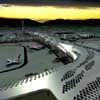
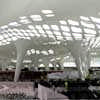
images from architect
Foster + Partners – Shenzhen Bao’an International Airport competition entrant
Kisho Kurokawa – Shenzhen Airport competition entrant
Location: Shenzhen Bao’an International Airport, Shenzhen, People’s Republic of China, Eastern Asia
Shenzhen Architecture Designs
Shenzhen Architectural Designs
Shenzhen Buildings – Selection
Shenzhen Stock Exchange Building
Hong Kong Architecture
Hong Kong Architecture Designs – chronological list
Hong Kong Architecture Tours by e-architect
Comments / photos for the Shenzhen Bao’an International Airport Architecture page welcome

